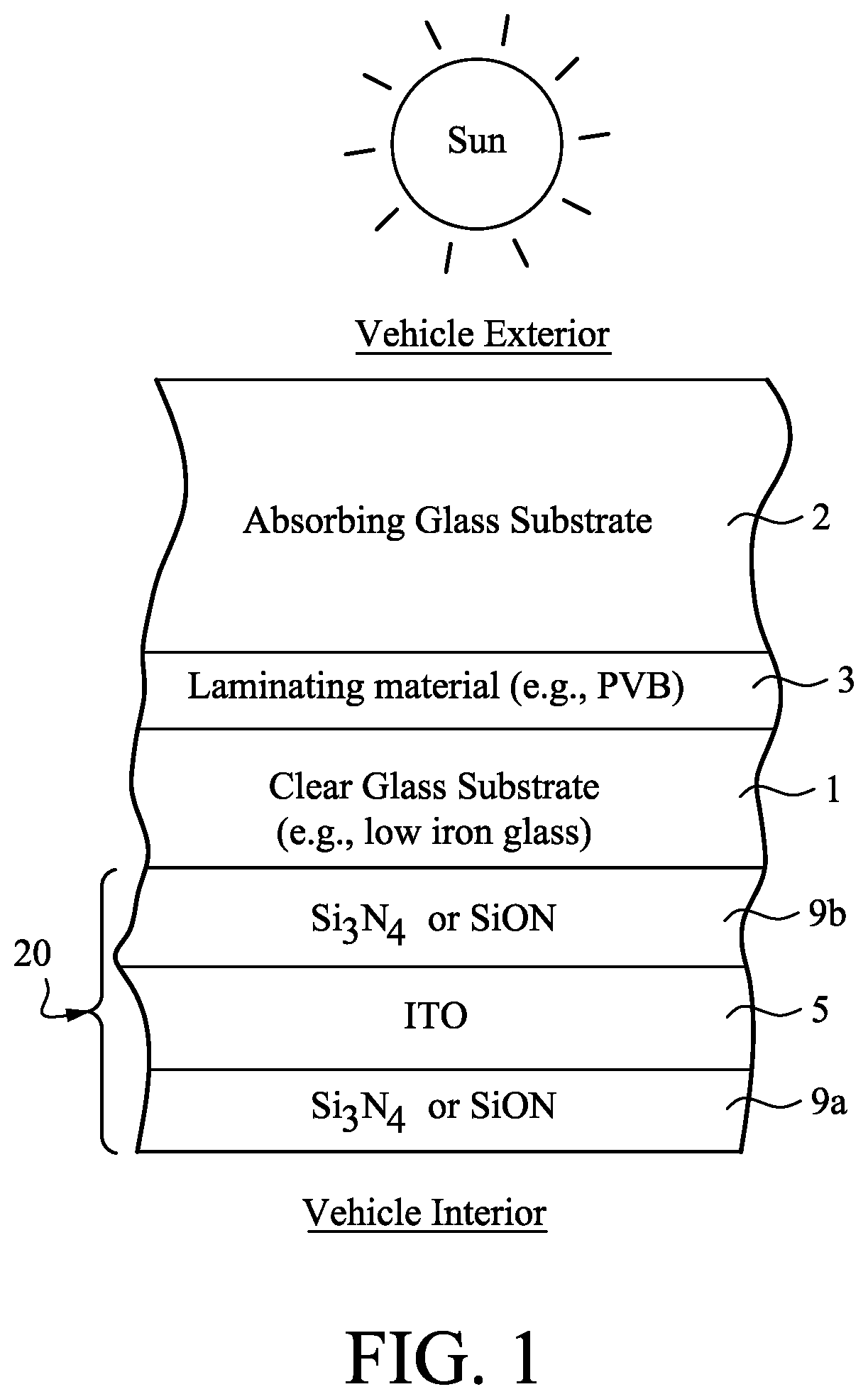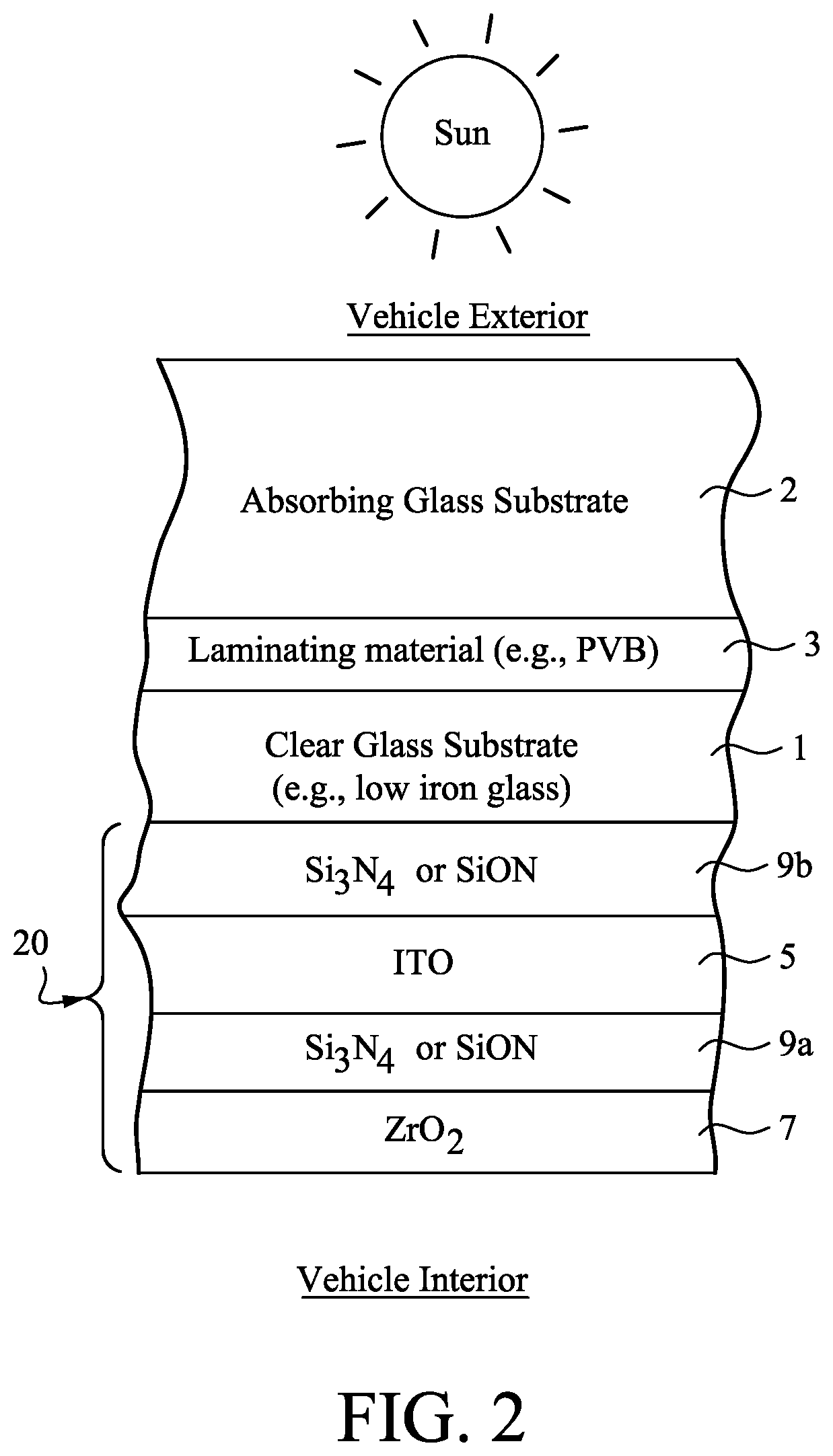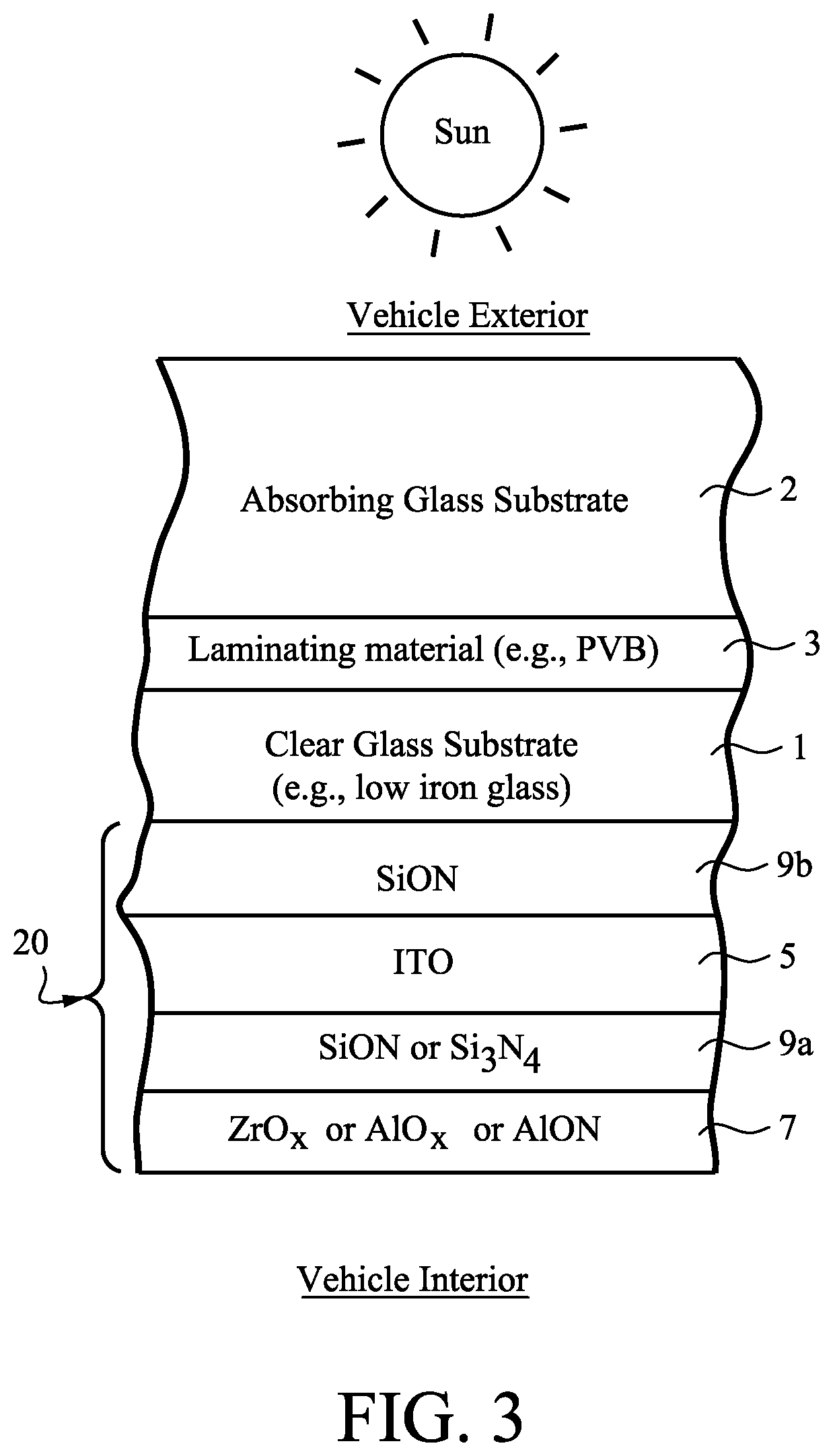Laminated window including different glass substrates with low-E coating adjacent vehicle or building interior and/or methods of making the same
a technology of low-e coating and glass substrate, applied in the field of laminate windows, can solve the problems of silver-based low-e coatings that are typically soft and easily damaged in processing, low-e reflecting, cost and complexity of manufacturing at the fabrication level, etc., and achieve the desired level of visible transmission, reduce solar heat load through the glazing, and reduce the effect of air conditioning load
- Summary
- Abstract
- Description
- Claims
- Application Information
AI Technical Summary
Benefits of technology
Problems solved by technology
Method used
Image
Examples
example 1
[0043]Example 1 was a laminated vehicle window according to the FIG. 1 embodiment, having a 2.5 mm thick clear low iron glass substrate 1 and a 4 mm thick green tinted higher iron glass substrate 2 laminated together with a 0.76 mm thick Saflex™ R clear PVB laminating layer 3. Coating 20 was provided, as shown in FIG. 1, on the surface of the inboard glass substrate 1 so as to face and be exposed to a vehicle interior. Coating 20 in Example 1 was made up of a 55 nm thick silicon oxynitride layer 9b, a 105 nm thick ITO layer 5, and a 60 nm thick silicon oxynitride layer 9a. In Example 1, the clear low iron inboard glass substrate 1 had a base glass composition of about 71.69% SiO2, 13.70% Na2O, 9.35% CaO, 4.07% MgO, 0.41% Al2O3, 0.23% K2O, and a small amount of salt cake; and a colorant portion of 0.09% total iron (expressed as Fe2O3), 0.0002% cobalt (Co3O4 or other suitable stoichiometry), 0.0013% chromium (Cr2O3 or other suitable stoichiometry), and 0.0007% erbium (Er2O3 or other s...
example 2
[0044]Example 2 differed from Example 1, in that in Example 2 both glass substrates 1 and 2 were low iron clear glass substrates, and no coating 20 was provided. Thus, Example 2 was a laminated vehicle window according to the FIG. 1 embodiment, having a pair of 3 mm thick clear low iron glass substrates 1 and 2 that were laminated to each other with a 0.76 mm thick Saflex™ R clear PVB laminating layer 3. In Example 2, both glass substrates 1 and 2 had a base glass composition of about 71.69% SiO2, 13.70% Na2O, 9.35% CaO, 4.07% MgO, 0.41% Al2O3, 0.23% K2O, and a small amount of salt cake; and a colorant portion of 0.09% total iron (expressed as Fe2O3), 0.0002% cobalt (Co3O4 or other suitable stoichiometry), 0.0013% chromium (Cr2O3 or other suitable stoichiometry), and 0.0007% erbium (Er2O3 or other suitable stoichiometry), in terms of weight percentage. The window of Example 2, after heat treatment, had a visible transmission of 89%, an exterior visible reflectance of 8%, an interior...
example 3
[0045]Example 3 differed from Example 1, in that in Example 3 both glass substrates 1 and 2 were relatively high iron green tinted glass substrates. Thus, Example 3 was a laminated vehicle window according to the FIG. 1 embodiment, having a pair of 3 mm thick green tinted relatively high iron glass substrates 1 and 2 laminated together with a 0.76 mm thick Saflex™ R clear PVB laminating layer 3. Coating 20 was provided, as shown in FIG. 1, on the surface of the inboard glass substrate 1 so as to face and be exposed to a vehicle interior. Coating 20 in Example 3 was the same as in Example 1. In Example 3, both glass substrates 1 and 2 were green tinted and each had a base glass composition of about 71.4% SiO2, 13.95% Na2O, 8.57% CaO, 4.05% MgO, 0.72% Al2O3, 0.21% K2O, and a small amount of salt cake; and a colorant portion of 0.78% total iron (expressed as Fe2O3), 0.0002% cobalt (Co3O4 or other suitable stoichiometry), 0.0012% chromium (Cr2O3 or other suitable stoichiometry), and 0.0...
PUM
| Property | Measurement | Unit |
|---|---|---|
| sheet resistance | aaaaa | aaaaa |
| thickness | aaaaa | aaaaa |
| thickness | aaaaa | aaaaa |
Abstract
Description
Claims
Application Information
 Login to View More
Login to View More - R&D
- Intellectual Property
- Life Sciences
- Materials
- Tech Scout
- Unparalleled Data Quality
- Higher Quality Content
- 60% Fewer Hallucinations
Browse by: Latest US Patents, China's latest patents, Technical Efficacy Thesaurus, Application Domain, Technology Topic, Popular Technical Reports.
© 2025 PatSnap. All rights reserved.Legal|Privacy policy|Modern Slavery Act Transparency Statement|Sitemap|About US| Contact US: help@patsnap.com



